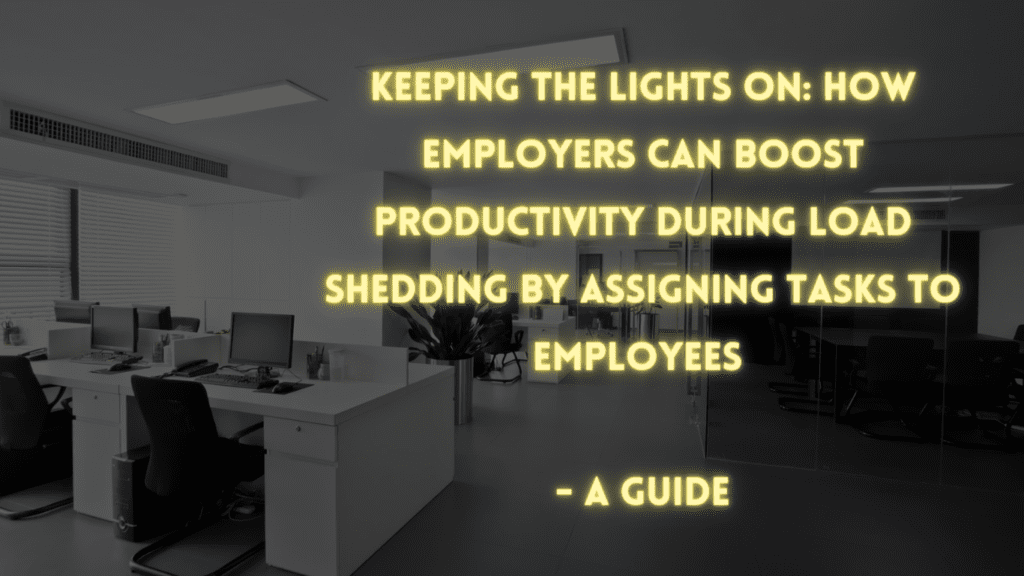
When the power goes out at work, it can feel like the end of the world. The computers are down, the lights are off, and everyone is twiddling their thumbs, waiting for the power to come back on. But what if we told you that a power outage doesn’t have to be the end of productivity? With a little creativity, you can turn this powerless situation into a power-packed opportunity. Here are some clever ways to make the most of load shedding:
Review Load Shedding Procedures
Load shedding procedures may be as unpredictable as your ex’s next move, but reviewing them with your team can help prevent chaos when the lights go out. Brainstorming new ideas to manage power outages can also brighten up your productivity during dark times.
Create an emergency plan that outlines what to do in the event of a power outage. This plan should include steps for shutting down equipment safely and quickly, identifying critical areas that need power backup, and contacting relevant personnel.
Make sure that employees know how to conserve energy during load shedding by turning off non-essential appliances and using natural light where possible.
Install backup generators or alternative power sources where necessary to ensure critical areas continue to function during a power outage.
Develop communication protocols to keep employees informed of the load shedding schedule and any changes to it. This could include using email, SMS, or a messaging app like WhatsApp.
Test the load shedding procedures regularly to ensure that everyone is familiar with the plan and that it works effectively.
Ensure that all necessary equipment is maintained and in good working order. This includes backup generators, batteries, and other power sources.
Have a designated person or team responsible for implementing the load shedding procedures and responding to any emergencies that arise during a power outage.
Provide training to employees on how to safely shut down and restart equipment, as well as how to troubleshoot common issues that may arise during load shedding.
Consider implementing energy-efficient practices and technologies that can reduce the impact of load shedding on the business.
Have a contingency plan in place in case of extended power outages or other emergencies. This could include alternative work arrangements, like remote work or temporary office space.

Conduct a Safety Check
One of the first things businesses should do during a load shedding event is to conduct a safety check. Load shedding can cause power surges and other hazards that may result in safety issues. Employees can inspect the workplace to ensure there are no hazards that may have resulted from the power outage. This can include checking for broken glass or other potential dangers.
Conduct a safety check: Prioritize employee safety by inspecting the workplace for hazards such as broken glass or exposed wiring that may have resulted from power surges during load shedding.
Create a backup plan: Develop a plan B that outlines how your business will operate during load shedding. This can include backup power sources or remote work options.
Implement energy-saving measures: Encourage employees to conserve energy by turning off lights and unplugging non-essential equipment during load shedding.
Communicate with employees: Keep employees informed about load shedding schedules and any changes in work arrangements. Utilize communication channels like email, text messaging, or company intranet to ensure everyone is on the same page.
Test equipment regularly: Regularly test backup generators and other equipment to ensure they are functioning properly and can be relied upon during load shedding.
Conduct Training
If there are any new software programs or equipment, use the time to train employees on how to use them. This can include safety training, as well as any new protocols that have been implemented during load shedding.
Load shedding can be a safety hazard for businesses, which is why it’s important to conduct a safety check as soon as possible. Encourage employees to inspect the workplace for any potential dangers, such as broken glass or tripping hazards. Additionally, consider investing in surge protectors to prevent equipment damage from power surges. Another idea is to create an emergency kit with flashlights, first aid supplies, and non-perishable snacks in case of a prolonged outage. By taking these precautions, businesses can ensure the safety of their employees and minimize the impact of load shedding on their operations.

Catch Up on Paperwork
Use the time to catch up on any outstanding paperwork or administrative tasks.
Do Some Brainstorming
During load shedding, employees can use the downtime to their advantage by brainstorming new ideas and strategies for the business. This is a great opportunity to think outside the box and come up with innovative solutions for dealing with power outages. Employees can share their thoughts and collaborate on new ideas that can help the business remain productive and efficient during load shedding. By doing so, the company can be better prepared for future power outages and ensure that productivity doesn’t suffer during these times.

Networking
During a load shedding event, it’s not just your business that is affected. Other businesses in the area are likely to be impacted too. While power is out, employees can take advantage of this time to network and build relationships with potential partners. This can be a great way to expand your business’s reach and form new connections that may lead to opportunities in the future. It’s also an opportunity to connect with other businesses that are also experiencing load shedding and brainstorm ideas on how to support each other during these challenging times. By taking the initiative to network during load shedding, you can turn a negative situation into a positive one for your business.
Complete Offline Tasks
During load shedding, employees can use the time to work on offline tasks that don’t require power. For example, they can review manuals, write reports, or complete paperwork. This is a great chance to catch up on work that may have been put on the backburner during busier periods. Additionally, employees can take the time to read up on load shedding guidelines and regulations. This can help them understand the situation better and come up with more effective solutions for dealing with power outages.
Clean Up the Workspace
During load shedding, businesses can take advantage of the downtime to tidy up the workspace and organize files. Decluttering the office can not only create a more pleasant working environment, but it can also help to reduce distractions and improve productivity when the power comes back on. This can involve tasks such as sorting paperwork, clearing out old equipment, and reorganizing storage areas. By taking the time to clean up and declutter during load shedding, businesses can start fresh and be better prepared for the next power outage.

Personal Development
During load shedding, it can be a great opportunity to encourage employees to focus on their personal development. With the power out, employees can use this time to read books or articles related to their job or industry, attend webinars or online courses to improve their skills, or learn something new that can benefit the business in the future. Additionally, employees can use this time to research and come up with new ways to conserve energy and reduce their carbon footprint during load shedding. This not only helps the business during power outages but also aligns with the company’s sustainability goals. By encouraging personal development during load shedding, businesses can turn downtime into a valuable learning experience for their employees.
Final Thoughts
While load shedding can be frustrating, businesses can make the most of it by keeping employees engaged and productive. In addition to the practical steps listed above, there are also several fun activities businesses can organize to help employees make the most of load shedding. From safety dances to load shedding fashion shows, there are many creative ways to keep employees entertained and engaged during power outages. With a bit of creativity and planning, load shedding can become an opportunity for businesses to build camaraderie, improve safety, and increase productivity.
Ever feel like your social media efforts are just a...
Have you ever tried looking up a local business online,...
Have you ever felt like potential customers just aren’t interested...



